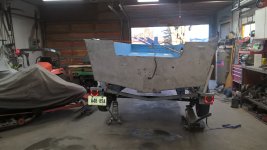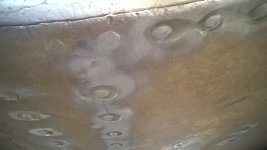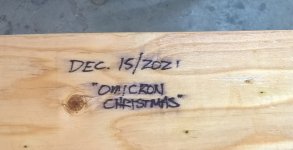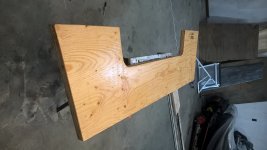BWR1953
Admiral
- Joined
- Jan 23, 2009
- Messages
- 6,178
How do you like the spray foam? It's one of the options I'm considering for my garage too....There is a layer of spray foam in the walls and ceiling...















How do you like the spray foam? It's one of the options I'm considering for my garage too....There is a layer of spray foam in the walls and ceiling...
It was applied by the previous owner when the place was built. Seems to make a pretty air-tight box, which is good. Of course, two roll-up doors, and three single-pane windows add some leaks to that box. From crawling up in the attic space, it looks like they only sprayed about 2" thick, but at about R5/inch, that's R10.How do you like the spray foam? It's one of the options I'm considering for my garage too.
Doors insulated? If not clad the inside with styrofoam SM. I don’t think a 230v electric will keep that size very warm. I’m 21x15. If you have the power in the panel, you could add a second heater, but for the cost, you may still be better off with a hot dawg or small gas shop heater. I’m sure your construction heater will keep the chill off at least though?Our workshop is about 24x36, with two garage doors on one end, 10' ceiling. There is a layer of spray foam in the walls and ceiling. I've got an old 230v construction heater kicking around. I think I need to wire up a different plug so it will connect to my welder receptacle. Should add that to my list.
I bet it makes a difference. I have a 4 panel wooden roll up door. I screwed styrofoam am to it. Going on 20 yearsThe doors are roll-up style, and the spray foam guys shot a layer of foam along the back of each panel. I suppose it's better than nothing!
Thanks.It was applied by the previous owner when the place was built. Seems to make a pretty air-tight box, which is good. Of course, two roll-up doors, and three single-pane windows add some leaks to that box. From crawling up in the attic space, it looks like they only sprayed about 2" thick, but at about R5/inch, that's R10.
Weather is well above freezing for the next couple days, so I hope to get a chance to get the boat outside to leak check again. I have riveted a small patch over the area where the corrosion pinhole was found, and applied G-Flex sparingly around all the rivet heads below the waterline. If any other leaks appear, I have solid rivets and tools to replace them now, so I'll proceed in that fashion prior to G-Flex'ing the inside.Looking good!!
One thing to keep in mind, if you tested water leaks prior to removing the paint, you might want to test again since you plan to leave it bare. The paint may have helped "seal" some of the rivets. Might be a worry wort, but something to ponder.
SHSU
Weigh her down!! Crazy winds todayWeather is well above freezing for the next couple days, so I hope to get a chance to get the boat outside to leak check again. I have riveted a small patch over the area where the corrosion pinhole was found, and applied G-Flex sparingly around all the rivet heads below the waterline. If any other leaks appear, I have solid rivets and tools to replace them now, so I'll proceed in that fashion prior to G-Flex'ing the inside.
Yeah, I bailed on today once the winds picked up! My son's snowmobile trailer went sailing across the yard and t-boned our maple tree. Hopefully I'll get a chance before cold weather returns.Weigh her down!! Crazy winds today



Make sure that goop plug is in good shape. I had a car topper tinny that was leaking badly there, and let water in fast. The reason I call it a plug, is because it was obviously a sealant injected down in the keel hollow where the bow was pulled together. It had shrunk and was loose so I pulled it out and shot a pile of 3M-5200 down there and packed the hollow of the open keel channel for 6” for good measureGot the water-test done! I ended up using trolley jacks to tilt the boat/trailer fore/aft and side-to-side, leaving it in each position about 30 minutes. There was a couple drips that passed through one rivet on the bottom, which I'll replace before going any further.
View attachment 353745
There was a drip forming at the bottom of the transom, right where the bottom skin is riveted to the transom. There are four or five rivets that are heavily worn, and could use replacing as well. I left the G-Flex off those, waiting for a suitable bucking helper to arrive on scene. Hopeful replacing rivets will tighten the joint and address that issue. See pic below.
View attachment 353746
The last leak area was up front, at the bottom of the keel area. It was by far the worst, dripping about 1 drip every 10 seconds with about a foot of water in the hull at that area. There is a big blob of dark 'goop' in the hull at that area that looks like it could be original. I'm open to recommendations on how to deal with this. Should I dig out the goop, and re-seal that area with G-Flex?
View attachment 353748
Overall I am encouraged that there aren't more issues to deal with. I did order a batch of Coat-It to liberally apply to the inner rivets and seams, but am hoping to apply this to an already sealed hull, as 'insurance', prior to getting on with floor installation.
I kept mine in the fridge and it lasted a long time there....On the topic of 5200... I've only used it once, and found once the tube was opened, it cured solid pretty quickly. Any tricks for extending shelf-life once opened?
Keep a small hole and use a nail in it to seal it. Place in fridge and it should be good for a few uses. Pull the nail out each time and it won't be clogged.I kept mine in the fridge and it lasted a long time there.


